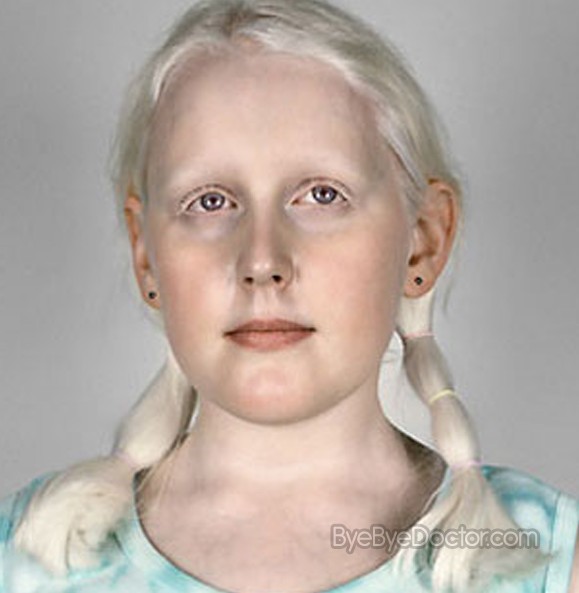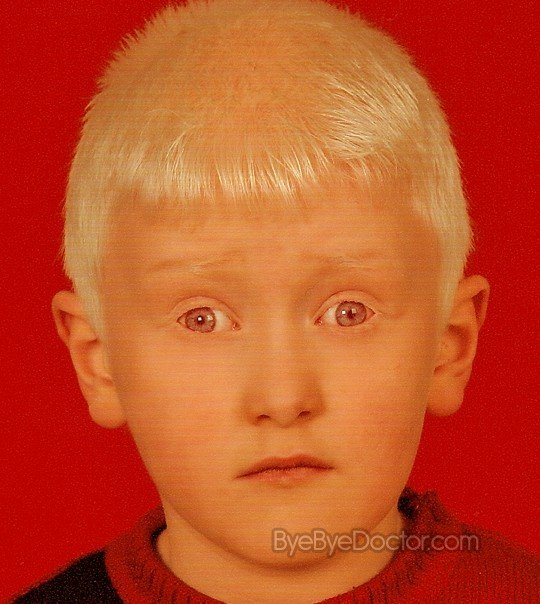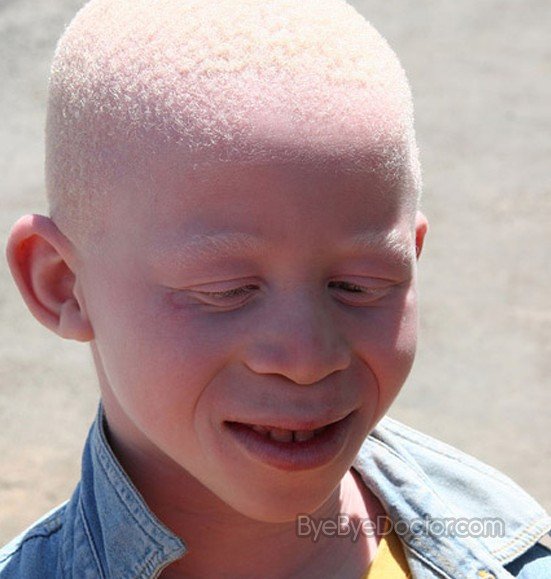What is Albinism?
‘Albinism’ refers to group of genetic disorders characterized by a partial or total lack of pigmentation in the hair, eyes, and skin of an individual. Albinism affects all races equally and 1 out of 17,000 persons in the United States has some form of albinism disorder. An individual with albinism is referred to as “albino”. Albinism is most noticeable in individuals belonging to races with dark skin and hair, and is sometimes overlooked in Caucasians, especially those of northern European descent. The expressed traits of albinism vary greatly according to the specific type the individual has, however all persons with albinism suffer from visual disturbances.
There are two main types of albinism:
In oculocutaneous albinism, the pigmentation of the hair, eyes, and skin are all affected to some degree. In ocular albinism, only the pigmentation of the eyes is affected. Ocular albinism is the rarer of the two forms, affecting approximately 1 out of every 60,000 men, and women to a much lesser degree. Ocular albinism is discussed below with the causes of albinism.
Oculocutaneous albinism, medically abbreviated as OCA, is the genetic disorder that is most people are referring to when they say “albino” or “albinism”. OCA is actually a group of disorders that vary according the exact mechanism of genetic dysfunction, however there are general symptoms displayed by all individuals affected by OCA as listed below:
Albinism Symptoms
- Reduced pigmentation of the skin and hair to some degree.
- Lack of pigmentation of the irises of the eye, causing them to appear translucent and sometimes red, caused by light reflecting from the retina.
- Vision disturbances related to photo-sensitivity, astigmatism, far-sightedness, near-sightedness, strabismus (crossed eyes), nystagmus (involuntary eye movements or “lazy eye”), or functional blindness.
Albinism Causes
Albinism is a genetically inherited disorder that occurs when a child inherits a recessive gene for albinism from each parent. Both parents must have the recessive gene to produce a child with two recessive traits, and thus have albinism. Statistically speaking, parents who both have a recessive gene for albinism will produce 25% children with albinism (two recessive traits), 50% children who are carriers for albinism (one recessive trait), and 25% children with no genes for albinism.
Currently, medical professionals have divided oculocutaneous albinism into four classifications based on the specific gene dysfunction that causes albinism. Each classification of OCA has a different method of action that causes specific albinism traits. The classifications are listed below:
Oculocutaneous albinism 1 (OCA1)
In individuals with normal pigmentation, the body converts an amino acid called tyrosine into melanin, or pigment. In OCA1, the body is unable to produce tyrosinase, the enzyme necessary to convert tyrosine into melanin. There are two sub-groups in this category, referred to as OCA1A and OCA1B. Individuals with OCA1A have a complete lack of tyrosinase and have white hair and very light skin, regardless of typical racial traits. In OCA1B, small amounts of tyrosinase are produced by the body, so individuals may have slightly pigmented hair and skin.
Oculocutaneous albinism 2 (OCA2, also called P-gene albinism)
This form of albinism affects the P-gene, which produces a protein necessary for tyrosinase to function. It is most common in Africans, those of African descent, and Native-Americans. The amount of melanin produced by these individuals varies, but they have noticeably lighter hair, eyes, and skin tone than is typical for their race.
Oculocutaneous albinism 3 (OCA3)
This is another form of albinism caused by a lack of a particular protein necessary to produce melanin. However, this form is rare and occurs most often in black South Africans. Individuals may be able to produce a significant amount of pigment and usually have light-brown to reddish skin, red hair, and hazel to light brown eyes.
Oculocutaneous albinism 4 (OC4)
This is another rare form of albinism mostly affecting East Asians, with characteristics very similar to OC2.
There are also a few other genetic disorders that involve albinism, however albinism is only a part of the disorder, and there are further genetic dysfunctions involved that lead to additional medical conditions. These disorders are listed below:
http://www.Symptoms-Causes-treatment.blogspot.com detect diseases at an early stage symptoms, and find out the causes and treatments best suited.
Hermansky-Pudlak Syndrome (HPS)
This is a rare genetic disorder causing oculocutaneous albinism, along with a bleeding disorder, and an abnormal storage of fat proteins that causes problems with the heart, kidneys, and lungs. HPS is most common in Puerto Ricans and Ashkenazi Jews.
Chediak-Higashi Syndrome
This is another rare genetic disorder causing partial albinism, neuropathy, and a dysfunction in the immune system, causing these individuals to very susceptible to infections. This disorder also causes the hair to be lighter than normal for the race with a silver sheen and the skin to be pale white to gray in color.
Ocular albinism
This is the second most common type of albinism next to OCA, but is still rare, affecting only 1 in 60,000. It is an X-linked recessive disorder, therefore it affects mostly men and rarely women. The symptoms are the same OCA, but only the eyes are affected. These individuals may have lighter skin or hair than their relatives, but the pigmentation is still within norms for their given race.
Albinism Treatment
Because albinism is a genetic disorder there is no treatment or cure for the disorder itself. Most children with albinism are born to parents who had no idea they carried a recessive genes for albinism and had no albino persons in their family. However, if a person does have relatives with albinism and suspects that they may be a carrier, they should seek an appointment with a genetic counselor. Genetic testing can reveal the risk of producing a child with albinism and genetic counselor can explain the implications and risks involved. There are also tests available that can determine if a fetus has inherited the recessive genes for albinism.
Most treatments available for albinism are related to the visual disturbances caused by the disorder. Almost all albino individuals require some sort of corrective lens and there are many specialty glasses made for patients with severe vision problems. Special eyeglasses called “bioptics”, made with both bifocal and telescopic lens, are particularly helpful to some patients with very poor vision.
There are also several surgical procedures that may be performed to correct or improve some eye conditions, such as crossed eyes or “lazy eye”. The surgical procedure may not be able to completely correct the condition, but can improve the patient’s field of vision. An ophthalmologist will perform an exam and recommend any of a variety of procedures that may help the patient.
There are other symptomatic treatments for albinism, as follows below:
- Sunscreen of at least 30 SPF (with UVA and UVB protection) should be used at all times due to increased risk of sun burns and skin cancers.
- Outside activities should be avoided in the middle of the day (when the sun is brightest), especially on very hot or sunny days.
- Sun-protection clothing and accessories should be used, such as sun hats, sun glasses, umbrellas, etc.
- Because albino eyes are particularly sensitive to light and glare, sun glasses can be helpful both outdoors and indoors.
- Vision aids, such as magnifying glasses and adjustable reading lights, can be very helpful.
Albinism Facts
It has been a common misconception for many years that albinism causes mental illnesses or mental retardation, although thankfully our society is becoming more informed about physical conditions and disabilities, and is moving beyond the stereotypes and misconceptions that have haunted us for so long. There is no correlation between albinism and mental illness or intellectual delay. Many children with albinism do attend special education classes in school, which has perpetuated the myth of mental retardation. However, the need for special education is related to severe visual disturbances or functional blindness, and not because of an intellectual deficit.
Albinism affects all races and geographical areas of the world equally, however it can be a socially isolating and stigmatizing condition. These stigmas seem to be more profound in areas with dark-haired, dark-skinned populations, and less so in populations where light-colored eyes and hair are found in the non-albino population. Persons with albinism have been notoriously persecuted and even murdered in areas of Africa, where albino people have been considered to be ‘bad luck’ and have been attributed with ‘evil, magical powers’. Attention from the media and the establishment of human rights organizations for albinism have halted these practices in modern times.
There are more incidental facts about albinism, as follows below:
- Albinism affects 1 in 17,000 people in the United States and equal numbers of men and women. The frequency of albinism is about the same worldwide.
- Albinism affects animals the same as it affects humans. Albino animals seem more rare because their vision impairments and lack of natural camouflage against predators leads to short life spans.
- The country of Tanzania in Africa has the highest population of albinos in the world, approximately 150,000-250,000.
- Ukerewe Island in Tanzania has the highest rates of albinism, approximately 1 in 4,000 people. Many albino African children were brought to Ukewere Island, where they would be safe from the persecution of albinos in other areas of Africa.
- Plants can also have albinism, however since pigmentation (chlorophyll) is necessary to their metabolism, they usually die within 10 days.
- There have been several famous persons with albinism throughout the world, including Edgar and Johnny Winter (brothers and American rock musicians), Connie Chiu (Chinese fashion model), Seinei (emperor of Japan), and Salif Keita (African pop musician and royal heir in Mali).
Albinism Pictures




